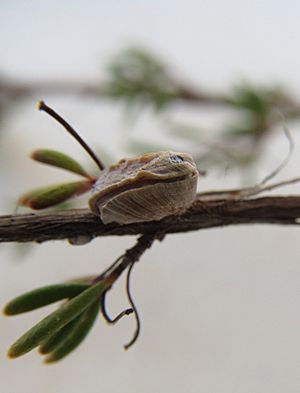Callococcus facts for kids
Quick facts for kids Callococcus |
|
|---|---|
 |
|
| Adult female of Callococcus pulchellus | |
| Scientific classification | |
| Kingdom: | |
| Phylum: | |
| Class: | |
| Order: | |
| Suborder: |
Sternorrhyncha
|
| Superfamily: | |
| Family: |
Eriococcidae
|
| Genus: |
Callococcus
Ferris
|
| species | |
|
|
Callococcus is a group of tiny Australian scale insects. These insects like to feed on plants from the myrtle family, like Leptospermum (also known as tea trees), Hypocalymma, and Kunzea.
One special type, Callococcus leptospermi, creates interesting swellings called galls on the stems of some Leptospermum plants. Scientists are even looking at it to help control Leptospermum laevigatum plants in South Africa. Other Callococcus species do not make galls.
Contents
What Do Callococcus Insects Look Like?
Just like most scale insects, we identify Callococcus species by looking closely at the adult females. Adult female Callococcus insects do not have wings. They also do not have legs, and their antennae are very small.
These females are shaped like small sacks. Their colors can range from a deep red (burgundy) to yellowish or brown.
Different Types of Callococcus Females
- Callococcus acaciae females are round and a red-burgundy color. They feed on Kunzea plants. These females are covered in a special, stretchy wax that comes from their bodies.
- Callococcus newmanni and C. pulchellus females look quite similar. Both produce a waxy covering that looks a bit like a small clam or seashell.
- C. leptospermi females are shaped like a sausage and are brownish. Once a young female starts to make a gall, she stays inside it forever. She will mate, have babies, and die inside the gall.
How C. leptospermi Babies Are Born
C. leptospermi is ovoviviparous. This means the babies grow inside the mother's body. They are nourished by special cells, not like a human placenta. The babies are born fully developed.
The first stage of young C. leptospermi insects are called crawlers. They are usually pink and have good legs and antennae. They also have many tiny, figure-8 shaped pores on their backs.
Interestingly, male and female crawlers of C. leptospermi look different from each other. This is unusual for scale insects. Adult male C. leptospermi insects have one pair of wings, just like other winged male scale insects. They are pinkish and have a long, thin body.
Where Do Callococcus Insects Belong?
The first Callococcus species, C. pulchellus, was described in 1897. At first, it was placed in a different group called Sphaerococcus.
However, in 1918, scientists realized it didn't fit there. So, the genus Callococcus was created for it.
For a long time, Callococcus was thought to belong to the family Asterolecaniidae. This was because the young insects had those special 8-shaped pores. Scientists thought these pores were unique to that family.
But recent DNA studies have shown something different. These studies look at the genetic relationships between living things. They showed that Callococcus is actually closely related to other Australian gall-making scale insects in the family Eriococcidae. Because of this, Callococcus was moved to the Eriococcidae family, also known as the felt scales.

